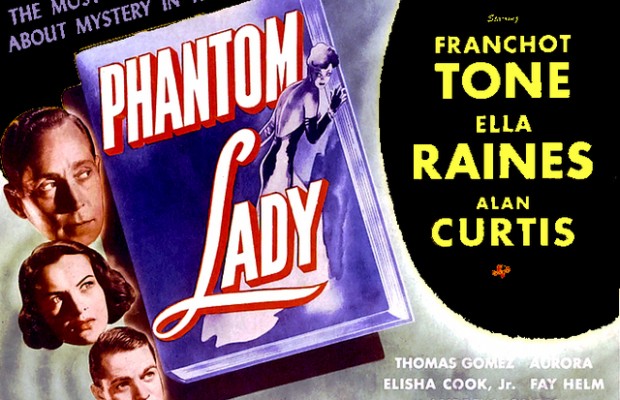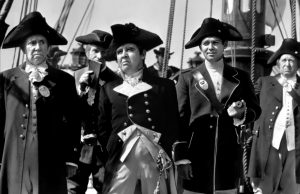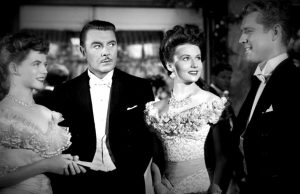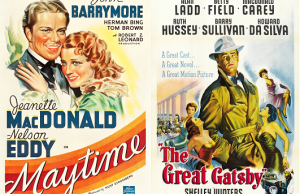Phantom Lady (1944)

Toronto Film Society presented Phantom Lady (1944) on Monday, January 21, 1974 in a double bill with Underworld, U.S.A. as part of the Season 26 Monday Evening Film Buff Series, Programme 3.
Production Company: Universal. Director: Robert Siodmak. Screenplay: Bernard C. Schoenfeld, based on the novel by Cornell Woolrich, writing as William Irish.
Cast: Franchot Tone (Jack Marlow), Ella Raines (Carol Richman), Alan Curtis (Scott Henderson), Aurora (Estela Monteiro), Thomas Gomez (Inspector Burgess), Fay Helm (Ann Terry), Elisha Cook, Jr. (Cliff), Andrew Tombes, Jr. (Bartender), Regis Toomey (Detective), Joseph Crehan (Detective), Doris Lloyd (Kettisha), Virginia Brissac (Dr. Chase).
Raymond Durgnat has pointed out that Phantom Lady is one of a deluge of films made in the Forties in the United States about portraits and missing women, including Laura, One Touch of Venus, Portrait of Jennie, Woman in the Window, and The Dark Corner (Clifton Webb trying to equate painting of the ideal woman with Cathy Downs). The theme intrigued Hollywood and was that of a man who was fascinated by the idealized image of a woman. The men who adhered to the ideal woman and ignored the real one usually suffered a severe downfall. In Laura, Dana Andrews makes the change easily (who wouldn’t, Gene Tierney is pretty close to the ideal–except, it’s pointed out, she lies a lot). Clifton Webb prefers the ideal and goes down for it.
In the Fifties Hitchcock, in Vertigo, picks up the theme and continues to modify it. This time it is not the man who goes down but the ideal (literally, Kim Novak in her “ideal” disguise falls from the “ivory” tower). It was up to The Pyx to pick up from where Hitchcock left off–on the ground with the dead woman’s body. This time we deal strictly with the real woman, albeit in flashback, who comes to fascinate Christopher Plummer, the policeman-investigator. There is o chance that the woman, Karen Black, can come alive like Gene Tierney–the real-ideal split is definitely out. Not only that but she is really “real”–not just a liar this time but a practicing prostitute junkie. Significantly The Pyx was not made in the U.S. Hollywood, for the most part, has given up on movies about male-female relationships.
Phantom Lady is really a murder mystery but the identity of the murderer is made known at an early stage and the search for the missing woman provides the main thread of the story. An interesting plot point to note is the occupation of the murderer. Colin McArthur has pointed out that Hollywood’s anti-intellectualism manifested itself many times by having the villain committed to art, usually as a collector or a critic (The Maltese Falcon, The Big Sleep, Laura, The Dark Corner). The real strength of Phantom Lady is its visual quality and film noir moodiness. Most critics agree that the script is not as strong as it could be. “Hollywood In The Forties” points out that “The story–from a pulp novelette about a search for an accused murderer’s alibis, most notably a mysterious woman in a bizarre hat met in a bar to the strains of ‘I Remember April’–becomes an excuse for the exploration of the underworld, for a series of descending spirals into hell”.
Taking place almost entirely at night, the glistening wet streets place this film visually in the film noir genre and, at the same time, with its play of light and shadow, it invokes the German expressionistic period. Durgnat views the heavy shafts of light in the condemned cell scenes as perhaps the last burst of expressionism in Hollywood. Andrew Sarris has pointed out that the films made by Robert Siodmak in Hollywood were more Germanic than his German ones. Siodmak, whose career began in Germany and France, made his first film in the U.S. in 1941. Phantom Lady, made in 1944, was his eighth Hollywood film. It was produced by Joan Harrison, a British writer-producer, who was an assistant for many years to Alfred Hitchcock. A great deal of attention was paid to this producership when the film was first reviewed. James Agee’s review attributed everything to Harrison–Siodmak was not even mentioned. Pauline Kael noted that “Siodmak’s Hollywood films, such as The Sprial Staircase, The Suspect, Phantom Lady, The Killer, and The Crimson Pirate, are much better known than he is–perhaps because his films are often mistakenly attributed to other directors or to highly publicized producers”.
Phantom Lady is peopled with familiar Hollywood faces in secondary roles. Most notable is Elisha Cook, Jr., the perpetual fall guy, who rarely survives on screen for more than one reel. There is one extraordinary scene he is in, a jazz jam session, that Agee describes as “a metaphor for orgasm and death–which in turn become metaphors for the jam session”. Agee pointed out that “the late reels of the picture slacken, and the ending, upon which Universal insisted, is half-heartedly done. But this is written as a would-be corrective of too much indiscriminate praise. There is plenty in Phantom Lady to enjoy, and to be glad of”.
Notes by Austin Whitten















Leave a Reply